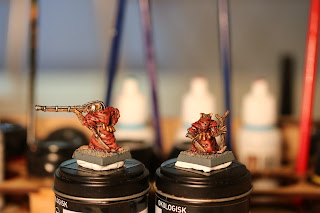I’m not quitting oldhammer – honest!
But sometimes you have to go where the games are, and in my case, that place is
called Malifaux.
As you might infer from that
description, it’s a game of wildly swinging moods and themes.
It is a game where a group (“crew”
in the game’s terminology) of Lovecraftian horrors might theoretically face off
against a crew made up entirely of pigs. That’s not a metaphor; I’m talking
about actual pigs here.
To illustrate just how good these
stories are (IMO), let me tell you that, though I’ve settled on collecting a
single crew (for now), there are at least five more that I want at some point;
three of which I only became aware of when I read a really engaging story about
them.
Malifaux has a couple of other good
qualities (from the perspective of someone who’s got an infant, a wife and a
house to take care of in his spare time).
Most importantly, you only need about
ten (relatively inexpensive) figures to play, depending on which crew you choose.
This means that, even though I only get about half an hour’s worth of painting
done each day, I might conceivably finish a crew before Christmas, which is more
than I can say for my dwarf army.
Secondly, Malifaux plays in one to
two hours, only requires a small table and a bit of scenery and has an active
community in my area, so I may actually get to play it once in a while without
having to travel to Bring Out Your Lead (not
a realistic proposition for me right now). I was always a gamer first and
painter second, so this is very positive.
Game-wise Malifaux is very modern, for lack of a better word. It’s build
around a familiar core (you take turns activating a model, each of which can
take 2-3 actions), but has some interesting twists.
For starters, you don’t roll dice,
but instead draw from a deck of playing cards to randomize results. Wyrd sells
custom decks, but you could just use a normal poker set.
Each turn you also get a hand of
(usually) five cards you can “cheat” in, if you don’t like your draw. As you
can keep cards in your hand from turn to turn if you don’t use them, this lets
you do some interesting things with probability-optimization and
hand-management. For example, do you keep a really low card in hand, so you won’t
draw it randomly, or do you discard it to, maybe, draw something better next
turn? Does your answer to that question change if you want to do something
important at the beginning of your turn? What about an average card, do you
keep that? And so on and so forth…
Another feature is that all models
have several special abilities – some of which can be combined into powerful
effects. As I said above, a model usually has 2-3 actions each turn, but under
the right circumstances, you can get as much as seven or eight (or even more, I’m
sure). This sounds broken as hell,
but when everyone can do stuff like that, it’s just what you have to expect and
plan for – and remember that you only have a few units, so you really need to
make each one count.
There’s a bunch of other stuff, but
if you’re really interested, you can download the rules for free here.
In a way, Malifaux feels a bit like
a cross between a miniatures game and Magic the Gathering. Now that may sound appalling
to some people, but it speaks to the board-gamer in me, so I like it.
I personally have very little
patience with blogs that go veering wildly off-topic for any length of time, so
I won’t bother you too much with all this newfangled nonsense, though I’ll
probably post some pictures of whatever I paint up, if only to avoid going
totally silent for the next couple of months.
Croaker



































